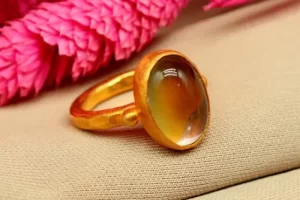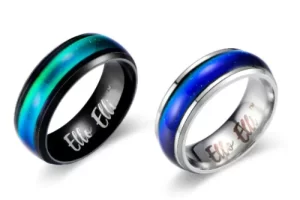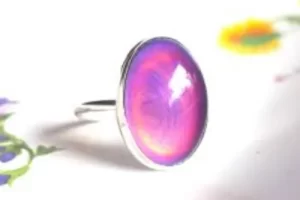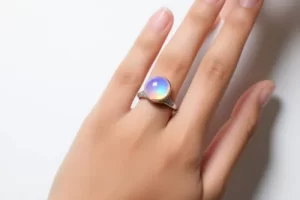Introduction to Mood Rings: The Electronic Boom of the 1970s
This article will take you back to the electronic 1970s and explore the popular mood rings. Mood rings originated in the 1970s. Along with the colorful neon lights and electronic dance music at that time, mood rings were at their peak when they debuted and were popular among a large number of people at that time. People bought it and it still fascinates people today because it is said to change color according to the mood of the wearer. But what do these colors really mean? How does the mood loop work? This article will provide you with detailed knowledge.

Understanding the Color Spectrum of the Emotional Circle
The great thing about a mood ring is that its color changes are not random. Its surface responds to changes in temperature. The mood ring changes color due to changes in the wearer’s body temperature. The following are the emotional meanings represented by the different colors of mood rings:
What does the black color in a mood ring mean?
If you wear a mood ring and its color changes to black, it means that you are under a lot of pressure and your whole person is in a state of excessive tension. When a person is nervous, it will increase the body’s metabolic rate, which will Let the body temperature rise. An increase in body temperature will cause the color of the mood ring to change to black.

What does the blue color in a mood ring mean?
Light blue indicates that you are in a calm and relaxed state. Contrary to black, it indicates that the wearer is in a stable and natural and peaceful emotional state. The color dark blue is associated with happiness. This color indicates that the wearer feels very relaxed. This color usually appears when listening to classical music, reading, or taking a lunch break.

What does the green color in a mood ring mean?
Medium green is the “default” color of mood rings. Most of the mood rings you see are basically green before you wear them. If the mood ring you are wearing shows green, it means that you are calm and relaxed now. This is the color that mood rings often display at room temperature, indicating that the wearer is neither overly excited nor particularly nervous. If the green becomes darker, showing a deep green, it indicates a deeper level of peace and happiness. It implies that the wearer is in a particularly comfortable state.
What does the yellow color in the mood ring mean?
There are many theories that the yellow color in mood rings represents emotions. Some people think that when the color of the mood ring changes to yellow, it means that the wearer is thoughtful, logical and has strong curiosity. Some people also believe that yellow represents an unstable emotional state, being upset, having difficulty concentrating, and always being in a state of thinking. It can also express complex emotions, such as contemplative and reflective emotions, according to people with different personalities.
What does the orange color in the mood ring mean?
The orange color in the mood ring represents that the wearer is under mild stress at this time and is in a state of confusion caused by tension. It may also represent that the wearer is in a state of mind that resembles a challenging life situation. Orange may also be associated with the sensation of warmth experienced during adventure sports, but it may also indicate that the wearer is in a worried mood.
What do the red and pink colors in a mood ring represent?
Deep red is a vibrant hue that often embodies strong emotions. This color can evoke feelings of enthusiasm, passion, or adoration. Additionally, it symbolizes energy, excitement, or adventurous endeavors. Sometimes, dark red can also represent anger or excitement, reflecting emotional frenzy or coercion. Conversely, when a mood ring comes in a rose color, it’s often a more serene and gentle emotional landscape than a crimson ring. It often conveys emotions of affection, warmth, and affection, albeit with more nurturing and less intense characteristics. Rose color also symbolizes a state of happiness, contentment and tranquility. However, it is important to acknowledge that mood ringtones, while providing insight into a person’s emotional domain, lack scientific accuracy in quantifying mood. Color shifts are more closely related to body temperature changes than to overt mood changes. Therefore, mood rings should be viewed as whimsical and fun decorations rather than firm measures of emotional state.

What does the purple in a mood ring mean?
Violet often symbolizes harmony and tranquility of the mind. They can represent feelings of emotional balance, calm, and harmony. Violet may also embody romance, passion, or tender emotions, but it has a more reflective and meditative side than the passionate emotions associated with crimson. In some interpretations, violets are associated with creativity and fantasy, reflecting a state of deep involvement in thought or artistic endeavor.
The Science Behind Mood Rings
Mood rings are made of thermochromic materials (usually liquid crystals), which can also change color through temperature. The material will change the molecular structure of its internal material according to temperature changes. Its structural changes allow The reflection of light changes, allowing people to see the mood ring changing colors. These color changes are indeed related to emotional state, but more to body temperature. Only the difference in temperature will cause them to change color.

Mood Rings as a Fashion Statement for Decades
Beyond mere decorative value, mood rings have become a sartorial statement over the decades, encompassing a fusion of styles and mystical allure. These rings have undergone periodic revivals in fashion, each echoing the unique spirit of their respective eras.
Their allure transcends the visual wonder of color change, providing a medium for personal expression. Different fashion subcultures have adopted mood rings, from bohemian artists seeking symbols that reflect their deep emotional layers, to retro enthusiasts who view these pieces as nostalgic treasures of a bygone era.
In the realm of modern fashion, mood rings have undergone a revolution. Fashion visionaries have reimagined the pieces, blending traditional thermochromic elements with contemporary design principles. The revamp caters to a new generation of fashion lovers who desire to blend the whimsy of yesteryear with the elegant tailoring of today. As such, mood rings persist not only as echoes of bygone fashion eras, but as timeless symbols that interweave fashion with personal identity, cultural trends, and an aura of mystery.

FAQs
- What is a Mood Ring?
A mood ring is a novelty piece of jewelry that changes its hue in response to changes in skin temperature and is often seen as a mirror of a person’s emotional landscape. - How Do Mood Rings Work?
These fascinating rings are filled with thermochromic substances, usually in the form of liquid crystals, that respond to changes in heat. When the wearer’s body temperature fluctuates, these crystals undergo structural deformation that changes the ring’s color. - Can Mood Rings Accurately Measure Emotions?
Although mood rings undergo color shifts with changes in temperature and may be affected by changes in mood, they do not serve as precise barometers of different emotional states. They function more like a fun and aesthetically pleasing accessory than a tool for scientific emotional assessment. - What Do the Different Colors in a Mood Ring Mean?
Typically, shades like sky blue or emerald suggest a calm and relaxed state, while warmer shades like scarlet or amber can mean energetic or tense. However, interpretations may vary. - Are Mood Rings Safe to Wear?
Generally speaking, the use of mood rings does not cause any damage. Still, people who are sensitive to certain metal components should carefully examine the ring’s material. Additionally, it is prudent to protect the ring from water exposure or extreme thermal conditions to maintain its structural integrity. - How Should I Care for My Mood Ring?
To extend the life of your mood ring, keep it away from water and protected from impacts, as thermochromic components can be easily damaged. It is recommended to use soft fabric for gentle cleaning. - Can Mood Rings Go Bad or Stop Working?
The thermochromic components within the mood ring may deteriorate over time, especially in harsh environments, resulting in a loss of its color-changing ability. - Where Can I Buy a Mood Ring?
These interesting rings are available in numerous jewelery malls, digital marketplaces and various fashion and accessories boutiques. - Is There a Variety in Mood Ring Designs?
In fact, contemporary mood rings showcase a range of styles from traditional to avant-garde to suit different sartorial preferences. - Can Children Wear Mood Rings?
Of course, children’s temperature changes are much more complicated than those of adults, and they can show many colors on their mood rings.
Conclusion: The Lasting Appeal of Mood Rings
Although they are a novelty item, mood rings have lasting appeal and have been popular in the jewelry industry for more than 50 years. They are special jewelry for people to socialize and feel their moods. They are unique from other jewelry. I believe that mood rings are the most popular jewelry in the world. It will still be accepted in the future.

